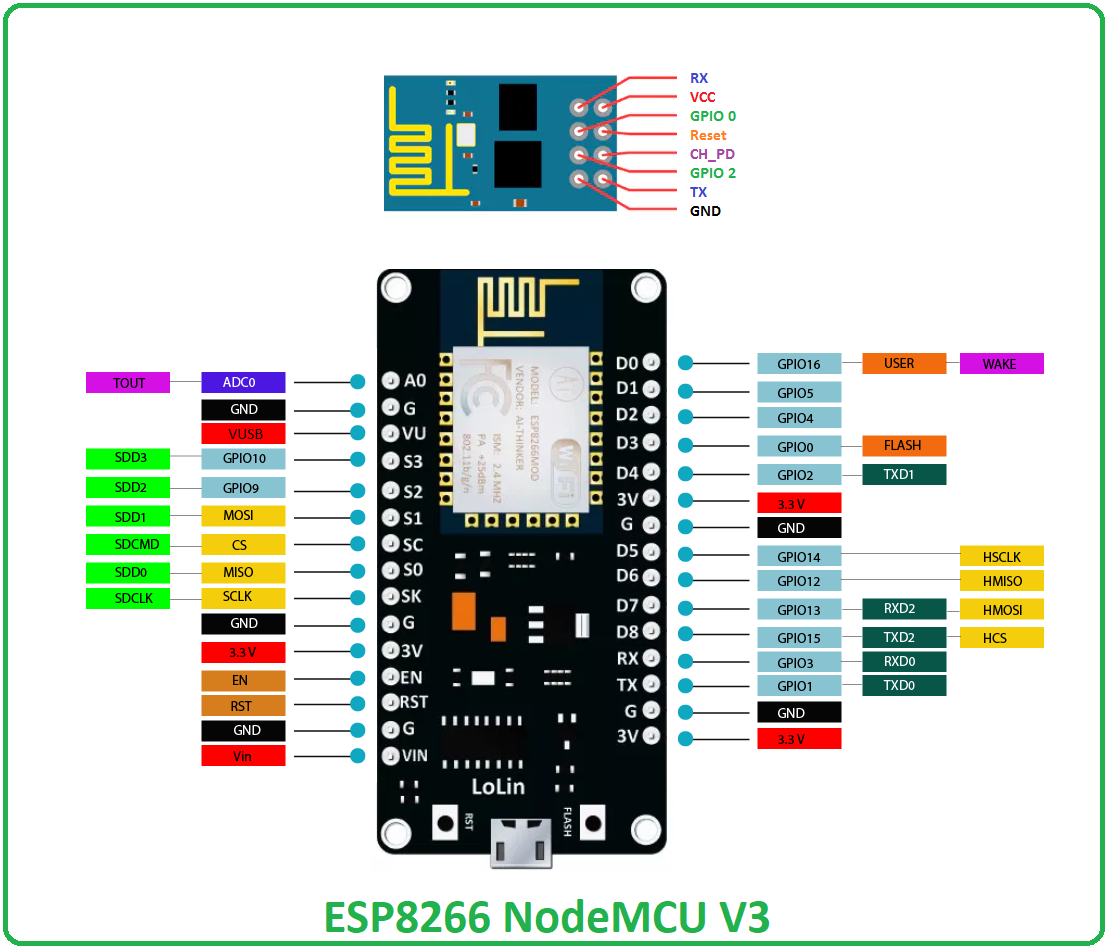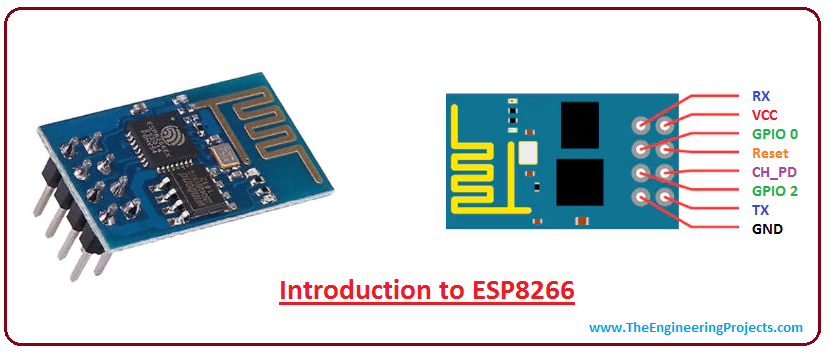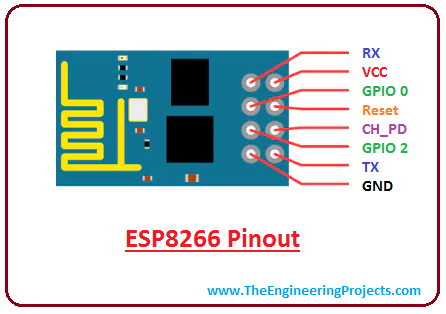
ESP8266 WiFi Module
- ESP8266 (also called ESP8266 Wireless Transceiver) is a cost-effective, easy-to-operate, compact-sized & low-powered WiFi module, designed by Espressif Systems, that supports both TCP/IP and Serial Protocol.
- It's normally used in IOT cloud-based embedded projects and is considered the most widely used WiFi module because of its low cost and small size.
- It runs at an operating voltage of 3V and can handle a maximum voltage of around 3.6 V, so an external logic level converter is required if you are using 5V supply.
- ESP8266 WiFi module can easily be interfaced with microcontrollers board (i.e. Arduino UNO) via Serial Port.
- There are numerous breakout boards available based on ESP8266 WiFi Module (i.e. ESP8266 NodeMCU V3).
- Beause of its compact size, its mostly used in autonomous projects (i.e. Robotics).

- Other than ESP8266, "Espressif Systems" has designed many other ESP WiFi modules, few of them are shown in below figure:

ESP8266 Pinout
- ESP8266 Pinout consists of 8 pins in total, which are given in below table along with their operation:
| ESP8266 Pinout | ||||
|---|---|---|---|---|
| No. | Pin Name | Working | ||
| 1 | RX | Serial Receiver Pin | ||
| 2 | Vcc | Power Pin (+3.3 V; can handle up to 3.6 V) | ||
| 3 | GPIO 0 | General-purpose I/O No. 0 | ||
| 4 | RST | Reset | ||
| 5 | CH_PD | Chip power-down | ||
| 6 | GPIO 2 | General-purpose I/O No. 2 | ||
| 7 | TX | Serial Transmitter Pin | ||
| 8 | GND | Ground | ||

- Each pin comes with a specific function associated with it where Vcc and GND are voltage source and ground respectively.
- RX and TX are used for communication where TX is dedicated for data transmission and RX is used receiving data.
ESP8266 Datasheet
- You can download ESP8266 Datasheet by clicking the below button:
ESP8266 Features
- It is also known as a system-on-chip (SoC) and comes with a 32-bit Tensilica microcontroller, antenna switches, RF balun, power amplifier, standard digital peripheral interfaces, low noise receive amplifier, power management module and filter capability.
- The processor is based on Tensilica Xtensa Diamond Standard 106Micro and runs at 80 MHz.
- It incorporates 64 KiB boot ROM, 80 KiB user data RAM and 32 KiB instruction RAM.
- It supports Wi-Fi 802.11 b/g/n around 2.4 GHz and other features including 16 GPIO, Inter-Integrated Circuit (I²C), Serial Peripheral Interface (SPI), 10-bit ADC, and I²S interfaces with DMA.
- External QSPI flash memory is accessed through SPI and supports up to 16 MiB and 512 KiB to 4 MiB is initially included in the module.
- It is a major development in terms of wireless communication with little circuitry. and contains onboard regulator that helps in providing 3.3V consistent power to the board.
- It supports APSD which makes it an ideal choice for VoIP applications and Bluetooth interfaces.
How to Power Up the Module
- You can power up the device with PC port using USB to Serial adaptor. The 2 AA and LIPO batteries are equally handy for powering up the device.
- It is advised to not power this device directly with 5V dev board. Doing so can severely affect the quality and overall performance of the device.
ESP8266 NodeMCU
- There are numerous breakout boards designed by different companies, based on this ESP8266 WiFi module.
- Among these breakout boards, ESP8266 NodeMCU is the most popular one.
- Here's the Pinout Diagram of ESP8266 NodeMCU:

ESP8266 Projects & Applications
ESP8266 WiFi module is widely used in embedded projects and thus brings WiFi capability. Here's few ESP8266 Projects & Applications:- Wireless Web Server
- Geolocation using ESP8266
- Pressure Sensors on Railway Tracks
- Air Pollution Meter
- Temperature logging system
- World’s smallest IoT project
- Wi-Fi controlled robot
- Humidity and temperature monitoring
- M2M using ESP8266



